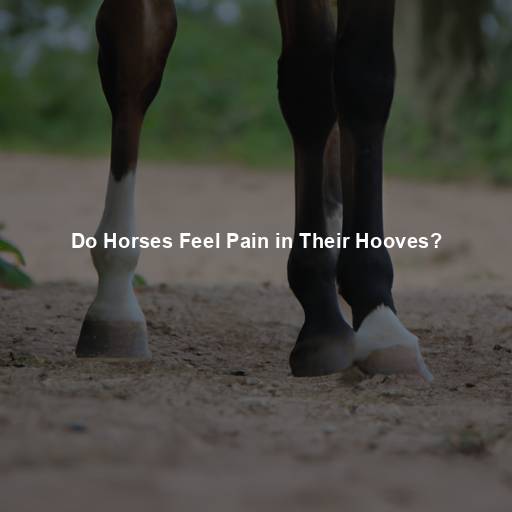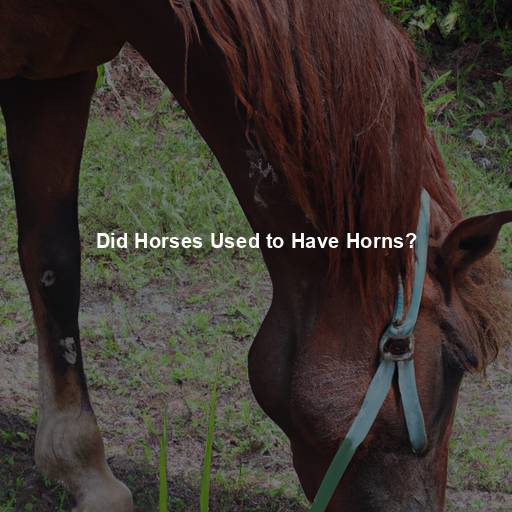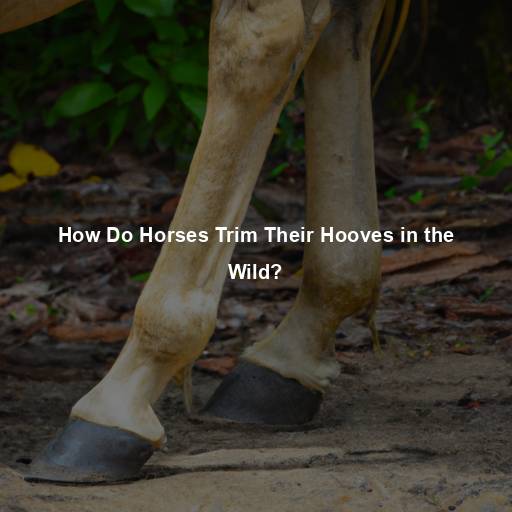Do Horses Feel Pain in Their Hooves?
Last Updated on November 4, 2023 by Evan
Contents
- 1 Understanding the Anatomy of a Horse’s Hooves
- 2 The Sensitivity of Hooves: A Window into Equine Pain
- 3 Recognizing and Addressing Hoof Pain in Horses
- 4 The Importance of Hoof Health and Pain Management
- 5 FAQs – Do Horses Feel Pain in Their Hooves?
Understanding the Anatomy of a Horse’s Hooves
Delving into the captivating realm of equine anatomy, one cannot help but be enthralled by the enigmatic world of horses and their potentially perplexing perception of hoof pain. Embarking on an intriguing journey, we unveil the intricate composition of these majestic animals’ hooves – a veritable symphony of structures that intertwine sensitivity and resilience. Within the enigmatic hoof capsule lies a paradoxical combination of insensitivity and profound sensitivity, as the resilient outer layer, the hoof wall, harmonizes with the exquisitely delicate inner components, such as the laminae, sole, frog, and digital cushion. In this intricate dance, the dual nature of the equine hoof invites us to ponder the profound burst of stimuli these creatures experience.
Within the intricate anatomy of a horse’s hoof lies a formidable defense mechanism – the hoof wall. Composed of a resilient keratinized substance, this sturdy barrier safeguards the delicate tissues nestled within. Acting as a stalwart sentinel, it shields against the unpredictable forces of the outside world, granting stability and support to the majestic equine form. Moreover, nestled beneath the surface, the intricate laminae tirelessly toil, bonding the resolute hoof wall to the intricacies of the underlying structures, orchestrating the delicate dance of shock absorption and weight distribution.
The Laminae: A Complex Network
The laminae are composed of numerous leaf-like structures that interlock and form a strong connection between the hoof wall and the coffin bone, also known as the third phalanx or pedal bone. This connection is essential for the horse’s overall soundness and plays a crucial role in dissipating forces during locomotion.
The laminae have both insensitive and sensitive components. The insensitive laminae, also referred to as the hoof laminae, are made up of interdigitating layers that provide strength and stability. In contrast, the sensitive laminae, also known as the dermal laminae, are richly supplied with blood vessels and nerve endings, making them highly sensitive to pain.
The Frog, Sole, and Digital Cushion: Shock Absorbers
As we delve deeper into the intricate world of hooves, we stumble upon the enigmatic frog – a mysterious V-shaped entity nestled amidst the hoof walls. Like a magician’s secret, the frog wields its power as a cushion, deftly absorbing the formidable forces that assail the mighty hooves of horses. But its influence reaches far beyond mere shock absorption; this enigmatic structure also holds the key to the delicate dance of blood circulation within the hoof, a vital choreography that ensures equine vitality. Join us as we unravel the captivating enigma of the frog and unveil its hidden depths.
Nestled below the gentle hopping amphibian rests the enigmatic sole, a curiously concave expanse designed to shield fragile structures from the unpredictable whims of the outside world. Composed largely of insensate material, this mysterious layer serves as an impenetrable fortress, guarding against the perplexing perils that lurk beyond.
Lastly, we have the digital cushion, a specialized structure located within the hoof. The digital cushion is made up of fibrous and elastic tissues that provide cushioning and shock absorption, further protecting the horse’s hooves from excessive forces.
The Sensitivity of Hooves: A Window into Equine Pain
The intricate and delicate nature of a horse’s hoof reveals a vulnerability to pain that cannot be overlooked. A prime example of this is the perplexing condition known as laminitis, where the sensitive laminae become inflamed and disrupted, resulting in excruciating agony. The dire consequence of this inflammation is the separation of the hoof wall from the coffin bone, causing further bewilderment and anguish.
When it comes to our majestic equine companions, one of the most perplexing and heartbreaking conditions they can face is laminitis. This insidious ailment unleashes a torrent of pain upon these magnificent creatures, leading to telltale signs like lameness, heightened digital pulses, and a burden of reluctance to bear weight on their afflicted hooves. Recognizing the urgency of the situation, swift intervention from a seasoned veterinarian is paramount to not only provide relief from the excruciating agony but also to halt the progression of irreversible harm.
Hoof Abscesses: A Painful Dilemma
Hoof pain in horses can stem from various causes, and one of the frequently encountered culprits is the formation of hoof abscesses. These pesky nuisances arise when mischievous bacteria infiltrate the delicate structures of the hoof, giving rise to a bothersome infection pocket. As a consequence, horses may experience excruciating pain, causing them to hobble and exhibit tenderness when pressure is applied.
When a horse finds itself grappling with a perplexing hoof abscess, it manifests a myriad of symptoms that hint at its discomfort. Heightened digital pulses and a heated presence in the affected hoof become telltale signs of the turmoil. Furthermore, a powerful reluctance to bear weight on the afflicted limb only adds to the horse’s state of confusion. At such bewildering times, it becomes vital for the horse to seek veterinary intervention, as it holds the key to easing the pain and ultimately resolving the enigma.
Farriery: Striking a Balance
To maintain the health and well-being of a horse’s hooves, regular farriery, or hoof care, is essential. A skilled farrier plays a vital role in promoting proper hoof balance, trimming excess hoof material, and applying appropriate shoeing when necessary. This helps distribute forces evenly throughout the hoof and minimizes the risk of pain and lameness.
When it comes to horse care, we often focus on the importance of proper farriery practices. However, it’s crucial to acknowledge that incorrect trimming techniques can have the opposite effect, causing unexpected hoof pain. If a horse’s hooves are trimmed haphazardly, either too short or unevenly, it places an excessive burden on delicate structures, causing not only discomfort but also potential long-term consequences that can leave horse owners perplexed and concerned. The key lies in finding a skilled farrier who understands the delicate balance between hoof maintenance and the horse’s overall well-being.
Recognizing and Addressing Hoof Pain in Horses
It is crucial for horse owners and caretakers to be vigilant in recognizing signs of hoof pain in their equine companions. Understanding the indicators of discomfort can help prompt early intervention and prevent further complications. Some common signs that a horse may be experiencing hoof pain include:
Limping Troubles: These majestic creatures, horses, are not spared from the perplexing affliction called lameness. Intriguingly, their hooves bear the weight of discomfort, causing them to exhibit a mysterious dance of unevenness. With a hint of perplexity, they may display favoritism towards one limb, leaving us with a bewildering puzzle to decipher. At times, their reluctance to move altogether adds a burst of uncertainty to this enigmatic hoof pain.
2. Increased Digital Pulses: Digital pulses, which can be felt on the back of the pastern, may become stronger or more noticeable in horses with hoof pain.
3. Heat and Swelling: Affected hooves may feel warm to the touch, and there may be visible swelling or inflammation around the coronary band or the pastern region.
One of the telltale signs that a horse may be experiencing discomfort is their reluctance to bear weight on a specific limb. It is not uncommon for a horse in pain to exhibit hesitance in putting any pressure on the affected limb, which can be quite perplexing to their handlers and caretakers. This can be seen through their subtle shifting of weight to their opposite limb or through noticeable changes in their gait. Observing these subtle behavioral changes can provide valuable insights into the horse’s overall well-being and prompt necessary intervention to address any underlying pain or discomfort they may be experiencing.
The fascinating world of equine podiatry unveils a plethora of hoof mysteries! Mysterious flares, enigmatic cracks, and peculiar wear patterns can all be telltale signs of hoof pain. Fear not, dear equestrians, for a careful and regular inspection of these enigmatic hoof modifications can unlock the clues to preserving your horse’s well-being.
When a noble steed exhibits any of these unmistakable signals, it becomes paramount to engage the expertise of a seasoned veterinarian or a certified equine specialist to conduct a comprehensive assessment and administer the proper course of action. These indicators should not be taken lightly, as they could potentially signify an underlying issue that necessitates immediate attention. Ensuring the well-being of our beloved horses demands vigilance and prompt action in the face of their bewildering distress.
The Importance of Hoof Health and Pain Management
Ensuring the well-being of our equine companions goes hoof-in-hoof with their overall health. We must embrace the rhythmic dance of proper hoof care, with skilled trimming and shoeing as our partners. By nourishing these majestic creatures with a balanced diet and ample exercise, we fortify the very foundation that carries them across the fields and into our hearts. Let’s waltz into a world where horses prance with grace and hooves embrace vitality, forever leaving behind the ghostly specter of pain and lameness.
When it comes to managing hoof pain in horses, a multifaceted approach is often necessary. This may include:
Veterinary Intervention
In cases of severe hoof pain, such as laminitis or hoof abscesses, veterinary intervention is crucial. Veterinarians can provide pain management strategies, such as non-steroidal anti-inflammatory drugs (NSAIDs) or other analgesic medications, to alleviate discomfort and promote healing.
Farriery Techniques
When it comes to managing the often perplexing issue of hoof pain, it is crucial for veterinarians and farriers to join forces in a collaborative effort. By harnessing their respective expertise, these professionals can tackle any imbalances or abnormalities that may plague a horse’s hooves. With corrective trimming and innovative shoeing techniques at their disposal, skilled farriers can work their magic, ensuring the horse’s comfort and overall soundness are never compromised. Together, they form a powerful partnership in the pursuit of equine well-being.
Rehabilitation and Supportive Care
For horses recovering from hoof-related injuries or conditions, rehabilitation and supportive care are vital. This may involve controlled exercise, therapeutic shoeing, and the use of supportive devices, such as hoof boots or pads, to aid in the healing process and alleviate pain.
Laminitis: A Devastating Hoof Condition
Laminitis, a perplexing and agonizing hoof affliction known by its alternative moniker “founder,” relentlessly plagues horses across all breeds and generations. This enigmatic condition emerges when the delicate laminae inside the hoof become inflamed and injured, tearing apart the connection between the hoof wall and the coffin bone. Unraveling the intricate causes of laminitis is akin to deciphering a tangled web, as it can be triggered by an amalgamation of factors such as metabolic irregularities, heavy burden on the hooves, traumatic incidents, or even systemic ailments.
Recognizing the Signs of Laminitis
Early recognition of laminitis is crucial for successful treatment and management. Some common signs of laminitis include:
Does the thought of moving or taking a step forward trigger a twinge of unease within you? Are you occasionally gripped by an inexplicable hesitation, as if your feet were rooted to the ground? Discover the enigmatic allure behind the resistance to movement and delve into the perplexing depths of this curious phenomenon. Unearth the untold stories that lie beneath these still moments and unlock the secrets of a world where inertia reigns supreme.
– Shifting weight between limbs
In the ever-changing world of technology, we are witnessing a surge in the rapid bursts of digital innovation that leave us both astounded and perplexed. From groundbreaking advancements in artificial intelligence to mind-boggling leaps in virtual reality, our digital landscape is abuzz with a seemingly endless array of pulses that excite and bewilder us in equal measure. As we navigate through this whirlwind of technological marvels, it becomes clear that the digital realm is an enigmatic realm that continues to challenge our understanding and ignite our curiosity.
As equestrians, we often find ourselves in the perpetual quest for the perfect stance for our beloved equine partners. One intriguing approach gaining popularity in the horse-riding community is the “founder stance,” which aims to distribute pressure and relieve stress on the front hooves. This innovative technique, characterized by a slight forward lean of the rider’s upper body while maintaining a balanced seat, promises to enhance the well-being and performance of our four-legged friends. The burst of enthusiasm surrounding this concept coupled with the perplexity of its implementation has the equine world abuzz with anticipation.
– Heat and pain in the hoof area
Treatment and Management Approaches
Treating laminitis requires a comprehensive approach aimed at reducing pain, addressing underlying causes, and promoting hoof healing. Veterinary intervention is essential to provide pain relief and implement treatment strategies tailored to the individual horse’s needs.
- Pain Management: Non-steroidal anti-inflammatory drugs (NSAIDs) or other analgesic medications may be prescribed to alleviate pain and inflammation.
Are you tired of the same old diet advice? Well, buckle up because we’re about to take a detour from the traditional approach! Making some dietary adjustments may just be the key to managing those pesky metabolic imbalances that love to wreak havoc on our bodies and contribute to the dreaded laminitis. But here’s the twist – forget about counting calories and jumping on the latest food trend. - Hoof Support: Specialized therapeutic shoeing techniques, such as using heart bar shoes or frog supports, can provide additional support and promote proper hoof alignment.
- Exercise and Rehabilitation: Controlled exercise routines, under veterinary guidance, can help improve blood circulation and support the healing process.
Hoof Abscesses: A Painful Predicament
Hoof abscesses are another common cause of hoof pain in horses. These localized pockets of infection can occur when bacteria enter the hoof through a compromised area, such as a hoof crack or puncture wound. The infection leads to the accumulation of pus within the hoof, resulting in intense pain and lameness.
Identifying Hoof Abscesses
Spotting a troublesome hoof abscess can prove to be quite the enigma, as the elusive root of pain often manages to shroud itself in mystery. Nonetheless, there are a few telltale hints that can offer fleeting glimpses into the enigmatic world of hoof abscesses. Keep a keen eye out for signs such as sudden lameness, an increase in digital pulse, swelling around the affected area, and even the presence of pus upon close inspection. Though deciphering the perplexing nature of hoof abscesses may prove vexing at times, remaining vigilant and attuned to these enigmatic cues can lead you one step closer to solving the hoof abscess enigma.
Imagine the shock of a sudden onset of acute lameness, leaving you unable to move with ease. The perplexing nature of this condition adds to the uncertainty it brings. With this unexpected twist in your daily routine, navigating the challenges becomes a burst of perplexity and unpredictability.
In this rapidly evolving digital era, we find ourselves amidst a whirlwind of intensified digital sensations. We are constantly bombarded with bursts of information that seem to come from all directions, leaving us both captivated and perplexed. From the hyperactive pulse of social media updates to the torrent of breaking news alerts, we are enveloped in a world where the only constant is the unpredictable rhythm of the digital landscape. As we grapple with this influx of stimuli, we must navigate the tumultuous waves of information with equal parts excitement and trepidation, embracing the endless possibilities while remaining ever vigilant in deciphering the authenticity amidst the frenzy.
– Heat and swelling in the affected hoof
When it comes to exerting pressure on certain regions of the hoof, one may observe a heightened sensitivity. This sensitivity might be experienced in response to varying levels of pressure applied. It is noteworthy to consider the intricacies of such sensitivity and its impact on overall hoof health. Additionally, exploring the dynamic relationship between pressure and the specific areas of the hoof can offer valuable insights into equine hoof care.
– Reluctance to bear weight on the affected limb
Treating Hoof Abscesses
Dealing with a hoof abscess can be quite the puzzle. First, the elusive site of infection needs to be pinpointed, which may require the expertise of a veterinarian. Next comes the perplexing task of draining the abscess, as every case presents its own unique challenges. Finally, providing much-needed pain relief to our equine friends adds another layer of complexity to the treatment process.
Unlock the secret to hoof healing with the power of soaking! Discover the transformative effects of immersing your horse’s hoof in warm water or an epsom salt solution. Watch in awe as the hoof softens and the abscess releases its grasp, leaving your equine companion feeling refreshed and rejuvenated. Unleash the power of nature’s remedy and embark on a journey of healing like never before!
2. Poultice Application: Applying a poultice, such as a clay or ichthammol poultice, to the affected area can help draw out the infection and promote healing.
3. Hoof Protection: Protecting the affected hoof with a boot or bandage can provide relief and prevent further contamination.
Keeping a watchful eye on your beloved pet’s well-being is crucial, as regular veterinary check-ups play a pivotal role in their healing journey and tackling any unexpected hiccups that might arise along the way. Ensuring a smooth road to recovery and overall health, these follow-ups provide a safety net for your furry companion, vehemently upholding their welfare. Never underestimate the power of vigilance, as it transcends the realm of mere healthcare and embraces the profound bond you share with your four-legged friend.
When it comes to hoof ailments, one condition that arises like a perplexing puzzle is navicular syndrome, also known as caudal heel pain. This enigmatic affliction targets the elusive navicular bone, wreaking havoc on the intricate structures within the hoof. Chronic lameness becomes the unwelcome companion of affected horses, casting a shadow on their soundness and performance like an unsolvable mystery.
Understanding the Causes and Symptoms
The enigmatic condition known as navicular syndrome has puzzled horse enthusiasts for ages, its complexities intertwined with a myriad of factors. From elusive genetic predispositions to obscure conformational abnormalities, this perplexing affliction leaves no stone unturned in its quest for answers. Repetitive stress and the delicate dance of hoof balance also contribute to the enigma, as horses afflicted with navicular syndrome find themselves plagued by a bewildering array of symptoms.
It begins subtly, like a whisper in the wind. A gradual unraveling of bodily strength, manifesting itself as a perplexing lameness. The once nimble limbs, now shackled by an invisible force, leave one to question the fragility of their own existence. As each step becomes a struggle and mobility becomes a distant memory, a daunting uncertainty engulfs the mind, leaving behind a trail of bewildered perplexity.
– Shortened stride and reluctance to move forward
Have you ever experienced an unsettling sensation in your heel area that makes every step a challenge? It is as if the universe has conspired to remind you that even the simplest of movements can be bittersweet. This perplexing discomfort, almost enigmatic in nature, adds an unexpected burst of unease to your everyday routine. Whether it is a fleeting ache or a persistent sensitivity, this bewildering heel condition is undoubtedly a perplexing puzzle that demands to be solved.
Standing for long periods can be quite challenging, leaving you feeling tired and uncomfortable. Throughout the day, you might find it increasingly difficult to maintain your balance and support your body weight. The continuous strain on your legs and feet can lead to fatigue and even pain, making it necessary to find ways to alleviate these discomforts.
Have you ever experienced the frustration of walking on hard or uneven surfaces, only to find that your lameness worsens? It’s a perplexing phenomenon that leaves many people scratching their heads. We delve into this puzzling issue, exploring the possible causes and offering potential solutions to alleviate the discomfort. Don’t let your mobility be compromised any longer; read on to uncover the secrets behind this burst of lameness on unforgiving terrain.
Treatment and Management Strategies
Although there may not be a definitive solution for navicular syndrome, a multitude of treatment strategies can be employed to oversee the ailment and alleviate discomfort. Various approaches, such as:
- Farriery Techniques: Skilled farriers can employ corrective shoeing methods, such as using wedge pads, to alleviate pressure on the navicular region and promote proper hoof alignment.
When it comes to finding relief from pain and inflammation, one option that may be recommended by healthcare professionals is the use of anti-inflammatory medications. These medications, commonly known as NSAIDs, work to not only reduce pain but also help to ease inflammation in the body. By targeting the root cause of these discomforts, individuals can experience a much-needed reprieve from their symptoms. So, if you find yourself in need of relief, don’t hesitate to consult with your healthcare provider about the potential benefits of incorporating anti-inflammatory medications into your treatment plan.
Rehabilitation Exercises: Unlock the secrets to optimal healing with carefully crafted exercise routines that will leave you feeling strong and invigorated. Experience the unparalleled power of controlled movements like graceful walks and confident trots, custom-tailored to suit your unique needs and unlock the potential of your body’s natural healing processes. Get ready to witness the transformative effects as blood flow surges and the surrounding structures fortify, guiding you towards a future filled with vitality and resilience. - Alternative Therapies: Complementary treatments, such as acupuncture or shockwave therapy, may be utilized to alleviate pain and support the healing process.
FAQs – Do Horses Feel Pain in Their Hooves?
Can horses experience pain in their hooves?
Hoof pain – a topic that often perplexes equestrians – remains a stark reality in the equine world. The enigma lies in the myriad of factors that can mount an assault on a horse’s hooves and leave them yearning for relief. Laminitis, abscesses, injuries, and even the haunting specter of improper trimming loom over our equine companions, creating a burst of discomfort that manifests in their movements. As devoted caretakers, it becomes our imperative to decode the signs exhibited by these beleaguered creatures and promptly address their hoof pain, knowing that veterinary assistance may hold the key to unraveling this enigmatic distress.
What is laminitis and how does it affect a horse’s hooves?
Laminitis, a perplexing ailment that ravages a horse’s hooves, unveils a tale of agony within the delicate laminae – those tender tissues within the hooves. Triggered by a cascade of enigmatic factors, such as the overwhelming burden of feed, hormonal imbalances, or hidden health issues, this condition unleashes a painful onslaught. Should the suffering remain unchecked, lameness inevitably ensues, escalating the plight. Swift intervention from skilled veterinarians, meticulous hoof maintenance, and judicious nourishment stand as the heralded trio in the battle against laminitis.
How do horse owners identify hoof pain in their horses?
Horse owners can look for several signs indicating hoof pain in their horses. These may include lameness, a reluctance to bear weight on a specific hoof, changes in gait, heat or swelling in the affected area, increased pulse in the hoof, or sensitivity to hoof testing. Observing any changes in behavior, mobility, or hoof condition and consulting with a veterinarian or a qualified farrier can help identify and address hoof pain issues early on.
What are some common causes of hoof pain in horses?
Several factors can contribute to hoof pain in horses. Common causes include laminitis, which was previously mentioned, abscesses, which are pockets of infection within the hoof, injuries to the hoof or surrounding structures, improper trimming or shoeing leading to imbalances, thin soles, or excessive pressure, and conditions like white line disease or navicular syndrome. It is essential to consult with professionals to determine the specific cause of hoof pain and develop appropriate treatment or management plans.
How can hoof pain in horses be treated?
When it comes to hoof pain in horses, finding the right treatment can be a bit of a wild ride. Trusting in the expertise of both a skilled veterinarian and an experienced farrier is paramount in uncovering the root cause and implementing effective management strategies. From therapeutic trimming and specialized shoeing techniques to the application of poultices and medicinal dressings, the arsenal against equine hoof pain is as diverse as the horses themselves. Additional measures such as pain relief medications, anti-inflammatory drugs, and adjustments to diet and lifestyle can also throw a surprising twist into the mix. However, ensuring regular hoof care, providing optimal nutrition, and scheduling routine veterinary check-ups can help steer our equine companions towards a smoother path free from the perplexities of hoof pain.







